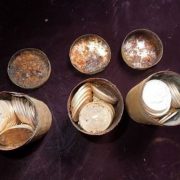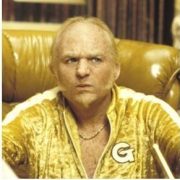California is called the ?Golden State? for a good reason.
Countless fortunes have been made in mining, farming, real estate, tourism, movie making, aircraft manufacturing, aerospace, and more recently, in technology and pot growing.
The Google (GOOG) and Facebook (FB) IPO?s each minted 1,000 millionaires, and Twitter?s (TWTR) deal is said to have produced 1,600 more.
Recently, a lucky couple found the real thing while hiking ?somewhere in Northern California.?
Spotting an old, rusted out tin can, they started digging. To their utter amazement they uncovered five cans containing 1,427 gold coins worth more than $10 million.
Speculation ran rampant as to the original source of the cache. During the Mexican period prior to 1848, the notorious bandit, Joaquin Murrieta, killed more than 40 people in robberies up and down the state. The booty was never found.
Black Bart waylaid 28 Wells Fargo (WFC) stagecoaches in Northern California in the 1880?s, and said he buried the loot near an old oak tree.
Some even postulated that the coins belonged to the sole surviving member of the Jesse James gang, who retrieved the gold on his release from prison in Missouri and then moved to California.
Things got really interesting when my old friend, Don Kagin of Kagin?s, Inc., got involved (click here for his site).
Don has been the feature of several of my past pieces about rare and exotic coins (click here for ?The Mystery of the Brasher Doubloon?).
After close inspection, Don concluded that the coins were in mint, unissued condition dating from 1847 to 1894. One coin alone, an 1866 Liberty $20 gold piece, is worth more than $1 million.
Don?s take is that the coins were stolen during an inside job at the San Francisco Mint in 1900, one of the few buildings to survive the 1906 earthquake. The surrounding fires burned so hot, that the gold coins inside melted.
The building still stands today. However, it is structurally unsound to continue as a Treasury building, so it is rented out for parties. If that is the case, the coins are still the property of the US government.
But the US Treasury never filed a claim, lacking the documentary evidence dating back to the period.
The government has done this many times in the past, fighting a ten year legal battle to recovers some stolen, unissued 1933 gold double eagle?s, the last minted prior to Franklin Delano Roosevelt?s ban on private gold ownership.
One of these sold for $7,590,000 in 2002, making it the world?s most valuable coin. The government won in that case.
The find sparked a stampede of similar gold seekers, turning hills into suspected neighborhoods into Swiss cheese.
Too bad the lucky hikers didn?t find their cache five years earlier. Since then the price of the barbarous relic has fallen by 45%.

 So Hiking Pays Off After All
So Hiking Pays Off After All






